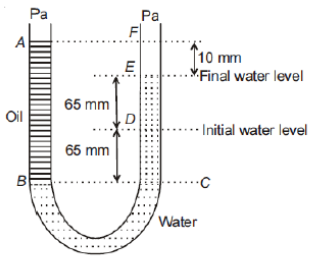A small sphere of radius r falls from rest in a viscous liquid. As a result, heat is produced due to the viscous force. The rate of production of heat when the sphere attains its terminal velocity is proportional to
1.
2.
3.
4.
A U tube with both ends open to the atmosphere is partially filled with water. Oil, which is immiscible with water, is poured into one side until it stands at a distance of 10 mm above the water level on the other side. Meanwhile, the water rises by 65 mm from its original level (see diagram). The density of the oil is

1. 650 kg
2. 425 kg
3. 800 kg
4. 928 kg
A rectangular film of liquid is extended from (4 cm x 2 cm) to (5 cm x 4 cm). If the work is done is 3 x J, the value of the surface tension of the liquid is
1. 0.250
2. 0.125
3. 0.2
4. 8.0
Three liquids of densities (with ), having the same value of surface tension T, rise to the same height in three identical capillaries. The angles of contact obey
1.
2.
3.
4.
The cylindrical tube of a spray pump has radius R, one end of which has n fine holes, each of radius r. If the speed of the liquid in the tube is V, the speed of the ejection of the liquid through the holes is
1.
2.
3.
4.
Water rises to a height h in capillary tube. If the length of capillary tube above the surface of the water is made less than h, then
1. Water does not rise at all
2. Water rises up to the tip of the capillary tube and then starts overflowing like a fountain
3. Water rises up to the top of capillary tube and stays there without overflowing
4. Water rises up to a point a little below the top and stays there
A wind with speed 40 m/s blows parallel to the roof of a house. The area of the roof is 250 . Assuming that the pressure inside the house is atmospheric pressure, the force exerted by the wind on the roof and the direction of the force will be ( = 1.2 kg/)
1. 2.4 x N, downwards
2. 4.8 x N, downwards
3. 4.8 x N, upwards
4. 2.4 x N, upwards
A certain number of spherical drops of a liquid of radius r coalesce to form a single drop of radius R and volume V. If T is the surface tension of the liquid, then
1. Energy = 4VT is released
2. Energy =3VT is absorbed
3. Energy =3VT is released
4. Energy is neither released nor absorbed
The wettability of a surface by a liquid depends primarily on:
1. Surface tension
2. Density
3. The angle of contact between the surface and the liquid
4. Viscosity